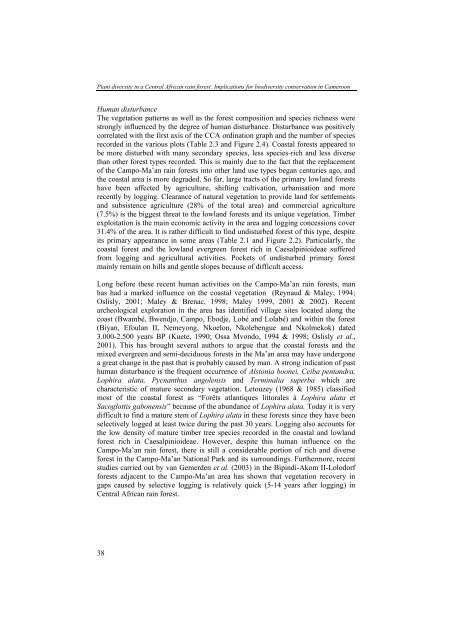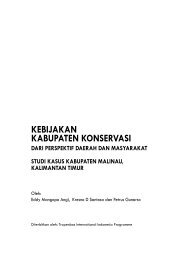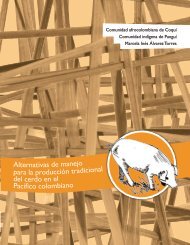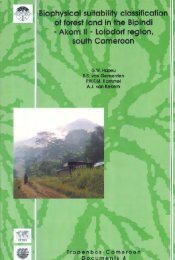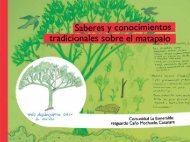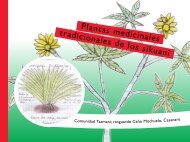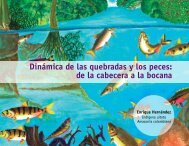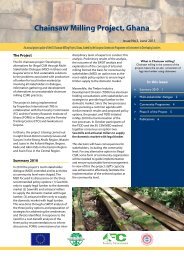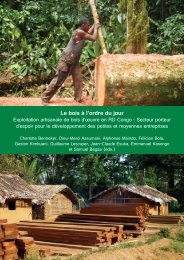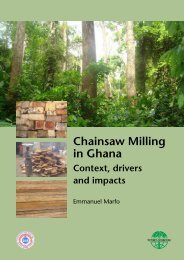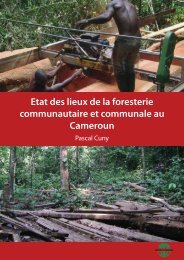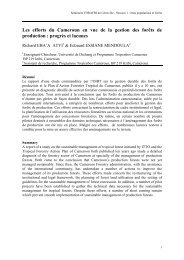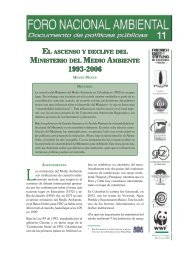Download the publication - Tropenbos International
Download the publication - Tropenbos International
Download the publication - Tropenbos International
You also want an ePaper? Increase the reach of your titles
YUMPU automatically turns print PDFs into web optimized ePapers that Google loves.
Plant diversity in a Central African rain forest: Implications for biodiversity conservation in Cameroon<br />
Human disturbance<br />
The vegetation patterns as well as <strong>the</strong> forest composition and species richness were<br />
strongly influenced by <strong>the</strong> degree of human disturbance. Disturbance was positively<br />
correlated with <strong>the</strong> first axis of <strong>the</strong> CCA ordination graph and <strong>the</strong> number of species<br />
recorded in <strong>the</strong> various plots (Table 2.3 and Figure 2.4). Coastal forests appeared to<br />
be more disturbed with many secondary species, less species-rich and less diverse<br />
than o<strong>the</strong>r forest types recorded. This is mainly due to <strong>the</strong> fact that <strong>the</strong> replacement<br />
of <strong>the</strong> Campo-Ma’an rain forests into o<strong>the</strong>r land use types began centuries ago, and<br />
<strong>the</strong> coastal area is more degraded. So far, large tracts of <strong>the</strong> primary lowland forests<br />
have been affected by agriculture, shifting cultivation, urbanisation and more<br />
recently by logging. Clearance of natural vegetation to provide land for settlements<br />
and subsistence agriculture (28% of <strong>the</strong> total area) and commercial agriculture<br />
(7.5%) is <strong>the</strong> biggest threat to <strong>the</strong> lowland forests and its unique vegetation. Timber<br />
exploitation is <strong>the</strong> main economic activity in <strong>the</strong> area and logging concessions cover<br />
31.4% of <strong>the</strong> area. It is ra<strong>the</strong>r difficult to find undisturbed forest of this type, despite<br />
its primary appearance in some areas (Table 2.1 and Figure 2.2). Particularly, <strong>the</strong><br />
coastal forest and <strong>the</strong> lowland evergreen forest rich in Caesalpinioideae suffered<br />
from logging and agricultural activities. Pockets of undisturbed primary forest<br />
mainly remain on hills and gentle slopes because of difficult access.<br />
Long before <strong>the</strong>se recent human activities on <strong>the</strong> Campo-Ma’an rain forests, man<br />
has had a marked influence on <strong>the</strong> coastal vegetation (Reynaud & Maley, 1994;<br />
Oslisly, 2001; Maley & Brenac, 1998; Maley 1999, 2001 & 2002). Recent<br />
archeological exploration in <strong>the</strong> area has identified village sites located along <strong>the</strong><br />
coast (Bwambé, Bwendjo, Campo, Ebodje, Lobé and Lolabé) and within <strong>the</strong> forest<br />
(Biyan, Efoulan II, Nemeyong, Nkoelon, Nkolebengue and Nkolmekok) dated<br />
3.000-2.500 years BP (Kuete, 1990; Ossa Mvondo, 1994 & 1998; Oslisly et al.,<br />
2001). This has brought several authors to argue that <strong>the</strong> coastal forests and <strong>the</strong><br />
mixed evergreen and semi-deciduous forests in <strong>the</strong> Ma’an area may have undergone<br />
a great change in <strong>the</strong> past that is probably caused by man. A strong indication of past<br />
human disturbance is <strong>the</strong> frequent occurrence of Alstonia boonei, Ceiba pentandra,<br />
Lophira alata, Pycnanthus angolensis and Terminalia superba which are<br />
characteristic of mature secondary vegetation. Letouzey (1968 & 1985) classified<br />
most of <strong>the</strong> coastal forest as “Forêts atlantiques littorales à Lophira alata et<br />
Sacoglottis gabonensis” because of <strong>the</strong> abundance of Lophira alata. Today it is very<br />
difficult to find a mature stem of Lophira alata in <strong>the</strong>se forests since <strong>the</strong>y have been<br />
selectively logged at least twice during <strong>the</strong> past 30 years. Logging also accounts for<br />
<strong>the</strong> low density of mature timber tree species recorded in <strong>the</strong> coastal and lowland<br />
forest rich in Caesalpinioideae. However, despite this human influence on <strong>the</strong><br />
Campo-Ma’an rain forest, <strong>the</strong>re is still a considerable portion of rich and diverse<br />
forest in <strong>the</strong> Campo-Ma’an National Park and its surroundings. Fur<strong>the</strong>rmore, recent<br />
studies carried out by van Gemerden et al. (2003) in <strong>the</strong> Bipindi-Akom II-Lolodorf<br />
forests adjacent to <strong>the</strong> Campo-Ma’an area has shown that vegetation recovery in<br />
gaps caused by selective logging is relatively quick (5-14 years after logging) in<br />
Central African rain forest.<br />
38


